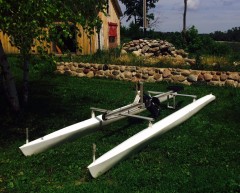Plunging into the MIA’s Target Galleries to see Leonardo da Vinci’s incredible Codex Leicester, on view through August 30, visitors come to a room containing works by a Minnesota boy born five centuries later. The connection might at first appear to be water: the codex pages show Leonardo struggling to understand the properties of water, while Scott Olson’s innovations—represented in the show by Rollerblade and SkyRide—produce water in the form of sweat.
But that wouldn’t quite be it. For “Leonardo da Vinci, the Codex Leicester, and the Creative Mind,” curator Alex Bortolot chose Olson as a present-day exemplar of the fertile, determined, searching, inventive mind. Olson was a hockey-crazed teen when he saw his first inline skate, dug into old patents, and began concocting a new version with family and friends in his parents’ Bloomington basement. But while Leonardo drew to think, filling his margins with intricate little machines and diagrams, Olson builds to think, moving quickly from ideas to working prototypes. Indeed, the highly collaborative Olson does not like to draw; the archival sketches in the show are renderings from artist friends based on his verbal descriptions.

A November 2012 City Pages cover imagined Olson as Vitruvian Man, referencing a famous Leonardo drawing about ideal proportions. Illustration photography by Bre McGee.
Like Leonardo in the early 1500s, Olson prizes experiment over abstract theory. One focus of his creativity were the wheels for his new inline skate design, launched in 1980 as Rollerblade. In the photo above he holds iterations from the early days, when he was still attaching wheels to hockey skates. (Whenever people tell Olson they owned some of the first Rollerblades, Olson asks what color wheels they had. Orange was early, followed by red. But cream, the very first color, puts them “in the elite club,” he says.)
The wheels in the exhibition are orange, originally polyurethane rollerskate wheels that Olson trimmed on a lathe so they’d be thinner and faster. “We cut away more than we used,” he says. After producing about 20,000 wheels this way, he had enough money to make his own mold and urethane formulas.
Soon he was searching for a wheel that gripped pavement better in rain. Before testing solid rubber wheels, Olson experimented with the bike wheel concept. Some $50,000 later, he had a tiny “air wheel” prototype that was the Tesla of Rollerblade wheels: really efficient and really fast. (Not surprisingly, Olson drives a Tesla.) He also had to invent a pump to inflate them. His dream wheel had to be abandoned, however. “If these things exploded from too much pressure while being pumped, it would be a disaster—or fatal,” he says.

Olson is curious to know whether a 1979 design with cream-colored wheels, fashioned from an old Lange hockey skate, still fits. The other dates to 1981. The exhibition features a similar model, only now with a bright orange toe brake.
As passionate about golf as he once was about goaltending—Olson left the University of North Dakota after three months to play hockey in Canada—he also experimented with wheels that glided on grass. Just as the codex shows Leonardo’s gift for applying a simple observation to a larger phenomenon, Olson made new Rollerblades with 6-inch wheels from wheelchairs. He tested them one summer on the Hyland ski hills in Bloomington, then on Meadowbrook golf course in Hopkins. Though fun, that idea was abandoned, too.
In the Codex Leicester (named for the Earls of Leicester, previous owners of the manuscript), Leonardo returns again and again to the question of how fossils ended up on mountaintops. Olson’s recurring issue is the different ways people can exercise while attached to a suspended track. The idea first hit him around 1992 when he was living on Lake Harriet Parkway in Minneapolis. Seeing all the traffic on the lake paths, he says, “I got a vision of a multitiered bike path like a freeway.” He had a friend sketch his idea on the spot. That drawing, exhibited at the MIA alongside later prototypes, led to SkyRide, a track with fixed seats that users propel through the air. It, too, is gradually finding a market, most recently on Carnival cruise ships.
Still, Olson can’t sit back. What about a design that lets people like his 82-year-old father skate, without fear of falling, by buckling into a harness attached to a track hanging above, say, an old parking lot?
Leonardo da Vinci was in his 50s when he created the water-obsessed Codex Leicester. Now 56, Olson is also thinking about water. He still puts a hundred miles on his Rollerblades and Rowbike (another of his inventions) every week. But Olson, a Pisces, has a new idea: a rowing machine designed not for the gym but for actual water. His working model is a homemade catamaran with a rowing apparatus connected to a propeller. He’ll do more tinkering in Lake Waconia, near his home, later this summer. But no matter what invention comes next, he says, “Movement’s the key.”
Watch Olson explain his entrepreneurial instincts at his studio in rural Waconia, Minnesota, in this video made by the MIA


